The first Robbedoes Special album, Happy Family by Legendre & Cambré, came out yesterday. In addition to the standard 48-page, softcover edition, there is also a deluxe hardcover edition with 8 additional pages, with the cover seen above. To take a closer look at this new version of Spirou, here’s a scanlation of the preview sample (the first page translated by BrianL and the rest by Miriam, edited by Spirou Reporter) and an interview with the creators, from BM Mag #15.
The latest issue of Ballon Media’s magazine BM Mag features an interview with the two creators:
Marc Legendre and Charel Cambré: “Guided by Spirou”


“To put a modern twist on the classic stories of the Franquin era.” That’s what Marc Legendre and Charel Cambré want to do with their adventures of Spirou & Fantasio. On the first page of Happy Family, you step into the carnival atmosphere of the Brussels Midi Fair. An atmosphere that recalls the golden age of the famous Marcinelle school. However, readers have no time to get lost in nostalgia. The story leaps out of the starting gate with great pep. It’s Spirou as you’ve never seen him before.
How did this project originate?
MARC LEGENDRE: After Amoras, Charel and I wanted to do something else. We considered just about everything, until one day we discovered that we both dreamed of making a Spirou & Fantasio album. We thought that being Flemish we didn’t stand a chance, but Charel suggested that we nevertheless send publisher Alexis Dragonetti an email. Just thirty seconds later we had our reply: it was fine. We fell out of our chairs!
CHAREL CAMBRÉ: You know, the whole idea for Amoras sort of came from the Spirou by… [one-shot] series. I thought we could to do something like that for Flemish comics character, to make a more ‘adult’ spinoff. Initially we thought we would make an album in that series [a Spirou one-shot]. But soon it turned out that we had a whole bunch of ideas that didn’t really fit into the format. After consulting the publisher, the new Robbedoes Special series saw the light of day.
What’s your relationship to Spirou?
LEGENDRE: At home we had subscriptions to the Kuifje [Tintin] and Robbedoes [Spirou] weekly magazines, which perfectly complemented each other. And my mother had some of the early albums, which we children scribbled on with color pencils and crayons, making them worthless. So I came across the series at a young age, and it quickly become one of my favorites.
CAMBRÉ: I started reading comics with Jommeke and Suske & Wiske. But I didn’t really get into it until I was eleven. An acquaintance of my parents ran a café. It had a staircase, and on each step there was a stack of comic books for the customers. There I got to know Sammy, The Bluecoats, Asterix, and all the other series. I was instantly taken with Gaston, which I traced countless times in order to learn how to draw like that myself. Ever since I have been reading a lot of comics, which I really think you can tell in my drawings today.
What is your favorite Spirou & Fantasio story?
LEGENDRE: It’s not a full-length story, but when it comes to Bravo les Brothers, words fail me. “Genius” may be the one that comes closest. And Le Nid des marsupilamis (“The Nest of the Marsupilamis”), QRN sur Bretzelburg (“QRN Over Bretzelburg”) and Panade à Champignac (“Trouble in Champignac”) are all albums where humor and adventure are in perfect equilibrium. Story-wise and graphically they are outstanding.
How did the idea of your story come about?
LEGENDRE: We didn’t have to think long about it. We both consider Franquin’s albums unrivaled, and we knew straight away that we wanted that kind of atmosphere in our story. No cellphones, but only rotary phones, for example. If the setting works, the whole thing comes alive. The story begins at the Brussels Midi Fair, which we know from La Foire aux gangsters (“The Gangster Fair”). A funfair with a ball-toss booth, beautiful cars, crazy animals…
CAMBRÉ: That opening scene had to really set the tone. I tried to give it a typical sixties feel. That turned out to be more difficult than I expected. It’s not enough to put the characters in the right clothes and add some cars from that time period. Much is about the coloring and something elusive that is so characteristic of Franquin and his kindred spirits.
LEGENDRE: Then we went on to try to think up an adventure. That the Count of Champignac would play a role was clear. He’s a funny character and fun to draw. And what can such a man invent? Something that is extraordinary for the time period in which the story is set, but that has become commonplace since then. Something that could carry on into the next parts of the story…
How did you make the Spirou universe your own?
LEGENDRE: Just like I used to believe that Lambik [from Suske & Wiske] was a real uncle walking around somewhere, in my mind Fantasio really was working at the magazine. Franquin managed to bring to life not just the characters of Spirou and Fantasio, but their whole world. You believe there is a village called Champignac, you believe the Marsupilami exists – even Zorglub could be running around. That makes it very easy to immerse yourself into it. If someone asks you to tell them about your aunt, you don’t have to go look it up in an encyclopedia, the stories come on their own.
CAMBRÉ: I chose the drawing style I used for my Jump series. It feels very natural. Even though Franquin has always been my favorite comic artist, it would be completely misguided to twist myself into a knot trying to mimic him. The result will always be inferior to the original. I sought a mix of my own style and a way of drawing in which you can also feel the history of Spirou. That it makes lots of people think of Franquin is of course very gratifying.
Were you never afraid of walking in the footsteps of such a giant?
LEGENDRE: No, because we ourselves are fans first and foremost, and that informs our work. If something feels off, we pull the emergency brake immediately. We grew up with Suske & Wiske and Spirou & Fantasio. We shouldn’t have to figure out how Lambik would react in a particular situation, or what Fantasio would say. We didn’t intend to mess with the DNA of the heroes or the series. And then something happens that you can’t explain: the characters start guiding you instead of the other way around.
The vulture that you put in in some of the early pages is phenomenal, and brings to mind Franquin’s krwakakrwa and other fowl. [As far as I can tell, the “krwakakrwa” is actually the Dutch name of the bird from Les Schtroumpfs et le Cracoucass (De Smurfen en de krwakakrwa, in English as The Smurfs and the Howlibird) by Peyo & Gos. The intended reference may be to the Boumptéryx, a bird character created by Franquin and his assistants Roba, Jidéhem and Marcel Denis in 1959, or to Franquin’s bird drawings for the Monstres series of cartoon doodles. –SR]
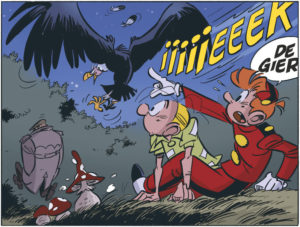
CAMBRÉ: Somewhere in my brain that bird is actually flapping around, so it’s not really all that difficult for me to draw it. If you put the two next to each other there are many differences, but the main thing to me is the ambiance the drawings give off. The way Franquin could draw a caricature, of things as well as characters, is inimitable. If he drew a pinball machine, it wasn’t a pinball machine, but a caricature of a pinball machine. Always spot on!
What character was the hardest to capture?
CAMBRÉ: Fantasio! But at the same time he’s my favorite to draw. Franquin drew him in a very specific way. His nose and big forehead are so recognizable, and each detail must be right to bring the character to life.
You’ve put a lot of winks and funny cameos in the background. Did that happen spontaneously?
CAMBRÉ: I can’t help myself! I do it with everything I draw. Usually it’s not in the storyboard at all. You shouldn’t overdo it, but a little Easter egg here and there for the “bonus hunters” and people who notice this kind of thing is fine.
Who are you inspired by in creating the stories?
LEGENDRE: Storytelling-wise, I can’t point to individuals, because it’s such a combination of different people. For me, not just a combination of different scripts or different writers, but also of people I have met who have nothing to do with comics.
What’s your goal for this series?
CAMBRÉ: I hope that the established fans enjoy our version, but above all that we manage to reach new readers. Spirou sometimes threatens to fly a bit below the radar in Flanders and the Netherlands. It would be great if we could make a new audience aware of who Spirou actually is.
Spirou is a seminal comic of the famous Marcinelle school. Are you gravitating more towards that style than towards the Flemish tradition?
LEGENDRE: Looking back, you could certainly say that, but it was never a conscious choice. Nero has always made me laugh a lot, one of my all-time favorites is De Koningin van Onderland (“The Queen of the Underworld”) with Jommeke, and the De duistere diamant (“The Dark Diamond”) with Suske & Wiske. But I also recognize that I don’t really make comics like that.
CAMBRÉ: It’s hard to say. When Flemish people look at my drawings, they do in fact often bring up the Marcinelle influence. But there’s also a lot of Jommeke and Suske & Wiske in my comics. Maybe to someone from France or Wallonia it feels really Flemish. I used to send many drawings to French-language publishers. They usually found them too Flemish.
How do you collaborate?
LEGENDRE: I write a script and submit it to the publisher. When it’s all set, it goes to Charel who then draws it. He doesn’t follow it slavishly, because then there’s no fun, neither for him nor for me. I usually can’t wait for Charel’s new sketches to arrive. We email from morning to evening, so it feels like we’re sitting next to each other.
CAMBRÉ: We often exchange the most stupid and frivolous ideas. We have the same sense of humor and laugh a lot. Often it’s not about the comics. We are both busy with many things at the same time. Marc and I have become very good friends, and maintain a peculiar long-distance relationship (laughs). But when it’s time to get to work, he’s a dream to work with. He really works on his scripts, having them ready long in advance. And he’s a fantastic sounding board for me.
What happens next?
CAMBRÉ: The script for the second part is done. I’ll start drawing in the coming weeks. It has to be done in September, so I’ll keep working. Then we’ll see. Hopefully it’s a hit, and Robbedoes Special expands into a full ongoing series… Wait and see!

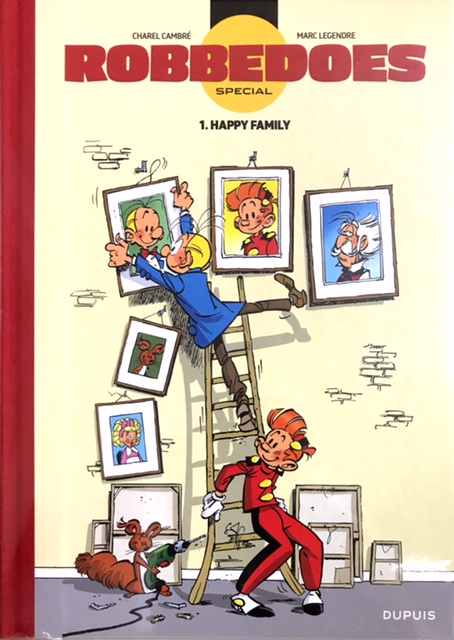
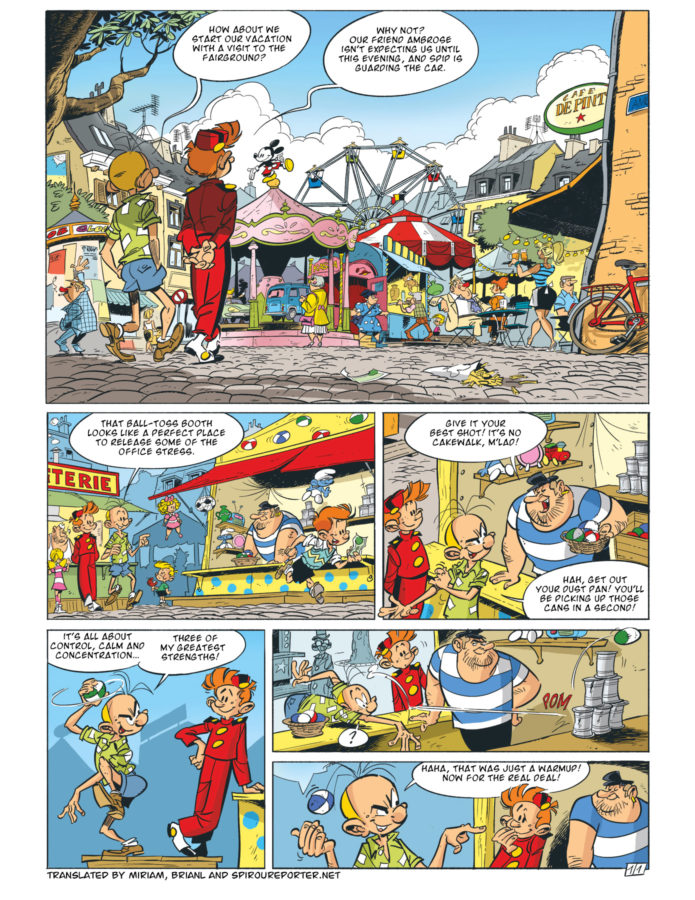
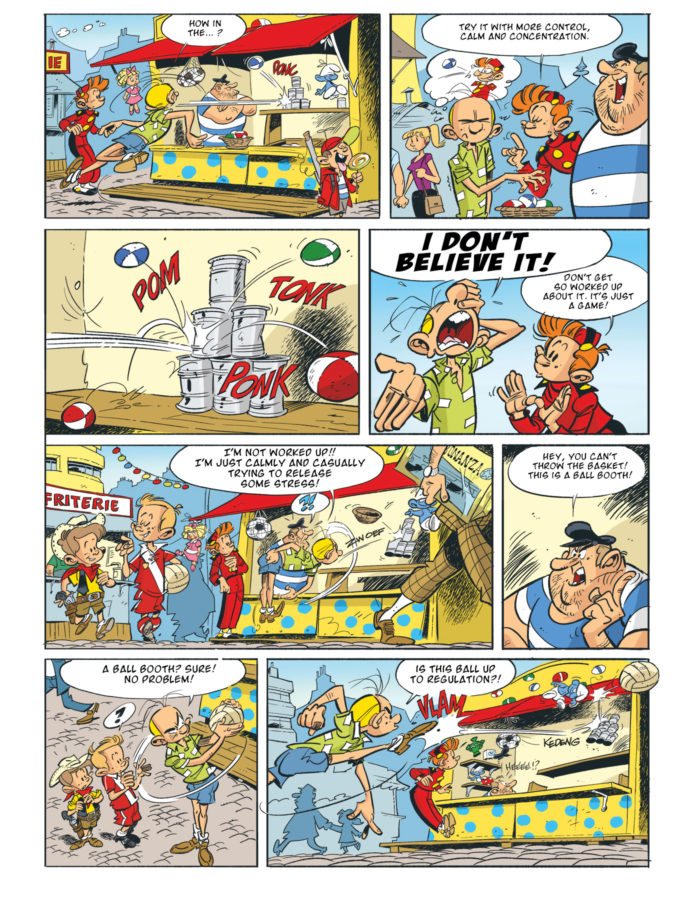
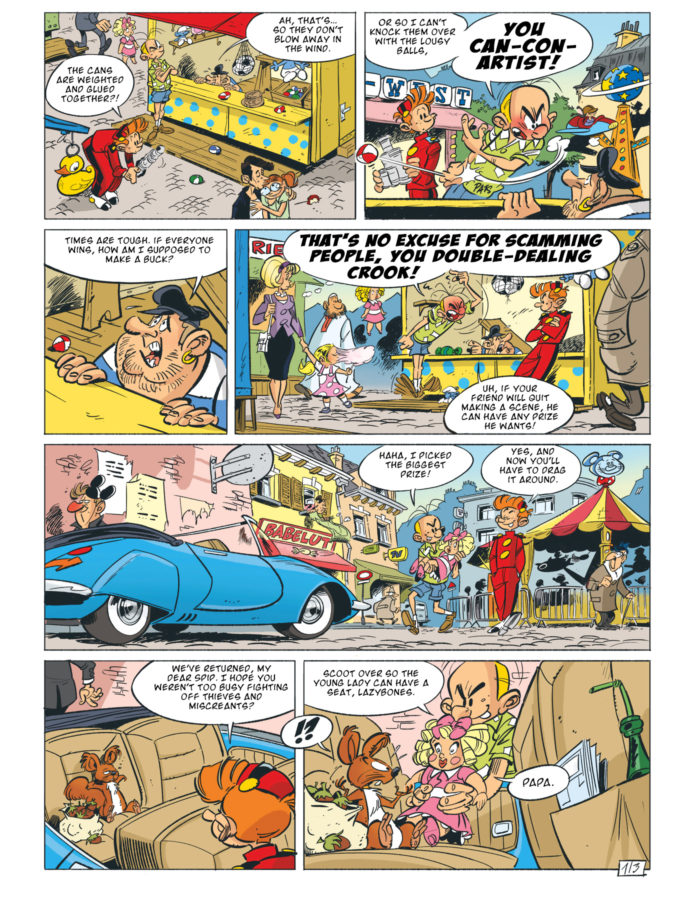
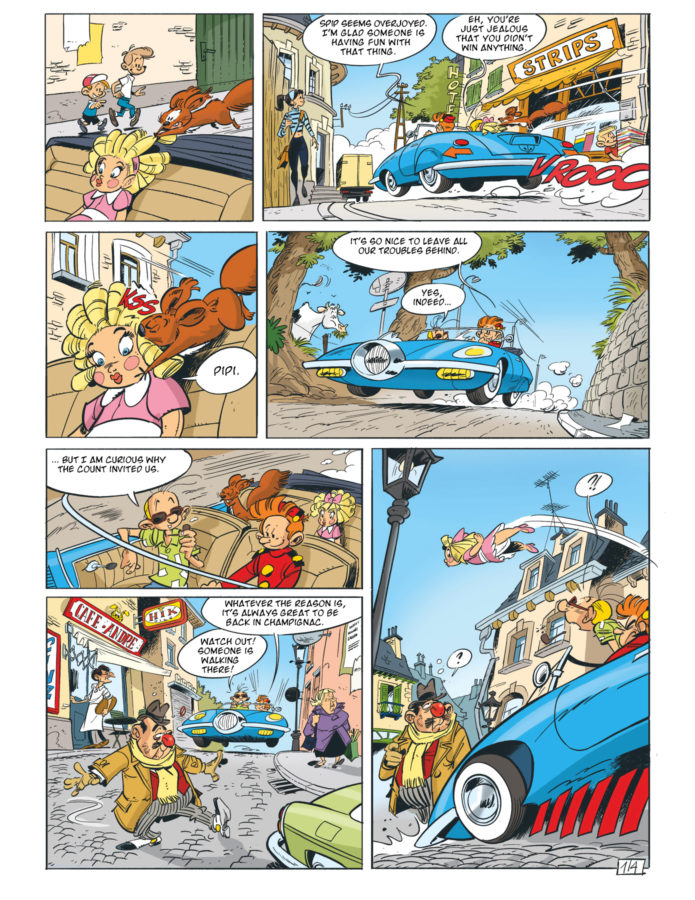
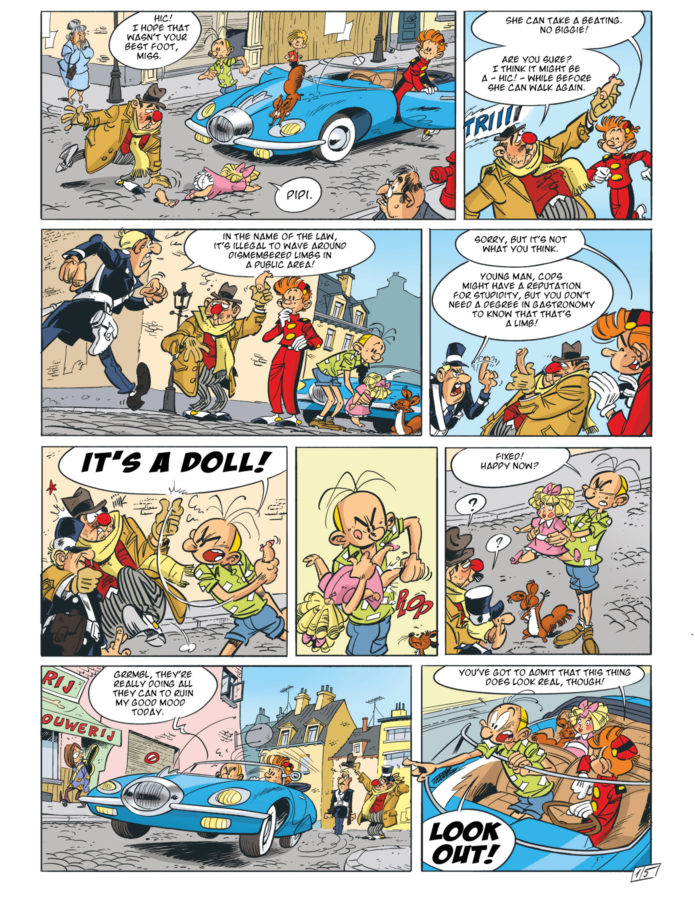
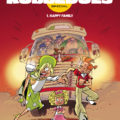
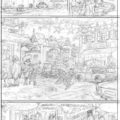

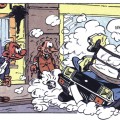
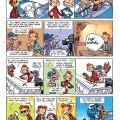
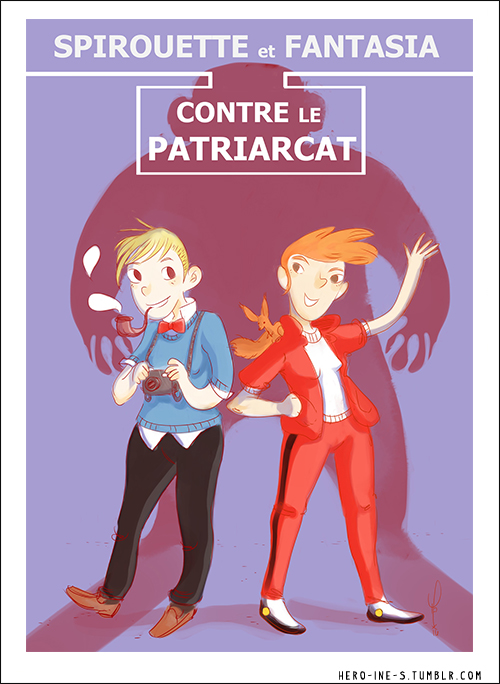
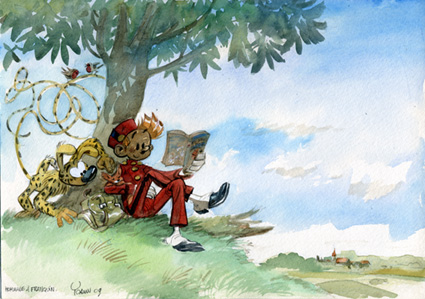
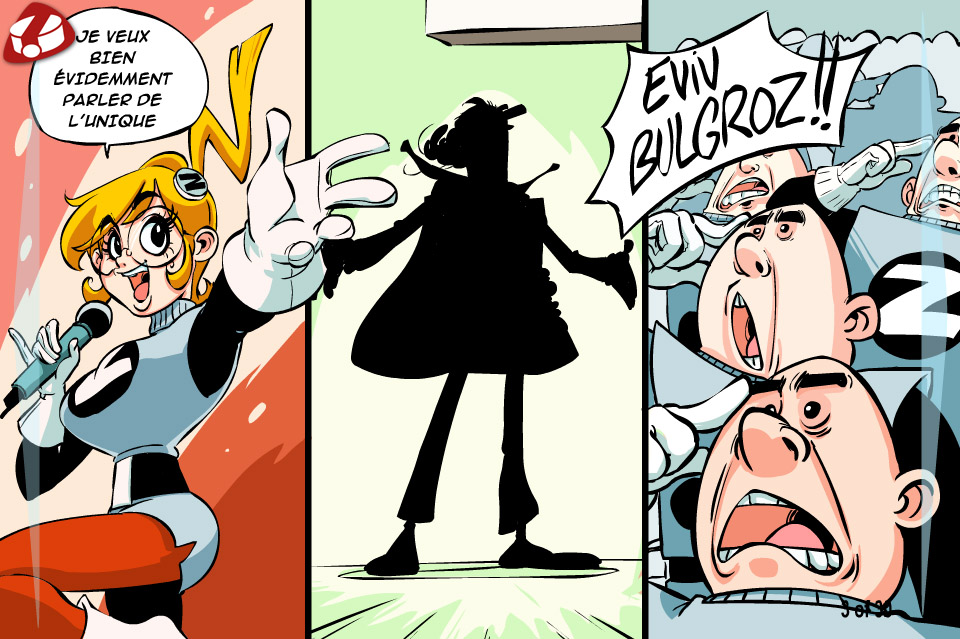
Curious, why did you change ‘geography’ to ‘gastronomy’? Other than that, all your edits make sense to me.
I reasoned that “aardrijkskunde” (geography) must be the cop saying the wrong word when he meant “ontleedkunde” (anatomy), since it’s anatomy you don’t need a degree in to recognize a severed limb. So I tried to come up with a word that sounded vaguely similar to “anatomy” in English. Also, I just think “gastronomy” is funnier. 😀
Okay. I’ve never heard of the word ‘ontleedkunde’, (I just say ‘anatomie’) but then, I’m Dutch and not Flemish. I don’t think ‘aardrijkskunde’ and ‘ontleedkunde’ are any similar. I agree that gastronomy is funnier.
Apparently, the original Cracoucass was invented and drawn by Franquin, although I believe the Cracoucass in the album was drawn by Peyo or one of his assistants.
http://www.franquin.com/amis/peyo_amis.php